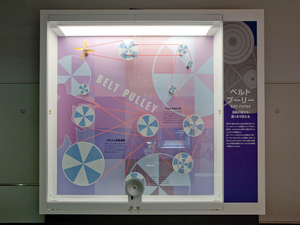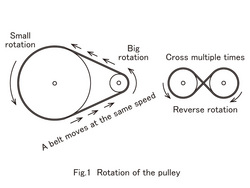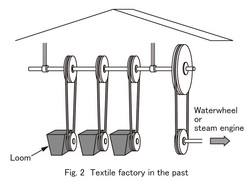Nagoya City Science Museum
TOP > Exhibition Guide > Floor Map> Belt Pulley
Belt Pulley

Purpose of Exhibition
There is a pulley in one of the mechanisms that transfers power. It is widely used because the power can be transferred easily. The purpose of this exhibition is to deepen your understanding about the principles and applications of pulleys.


Additional Knowledge
When turning the handle, many pulleys interlock through the belt. It shows that movement is changed by the size of the pulley diameter and how to put over the belt.
[Big Pulley and Small Pulley]
When big and small pulleys are connected by a belt, the rotation of the big pulley is gradual compared with the small one. It might be easier to understand if you imagine the entire length of the belt when moved in a given period of time remained constant (Figure 1).
[How to Put over the Belt]
The rotation direction of the pulley is the same as when usually putting over the belt. To make the pulley reverse, the rope should be crossed multiple times. After judging what kind of force should be applied and what kind of force is needed, decide how to put over the belt (Figure 1).
[Which should be used, a gear or pulley?]
The gear is well known as a mechanism which transfers force. Historically, pulleys have often been chosen as a tool of power transmission.
For this reason, a high level of accuracy has been required for manufacturing gears. The pitch, that is, the interval of teeth, should be completely in accord with all parts of one gear. If it is not, each gear might not rotate. It is thought that pulleys were used mainly until a machine tool with high construction accuracy was established.
It was only recently that electricity became the source of power. In 1871 (Meiji 4), just as Japan had entered the Meiji Restoration, the Imperial College of Engineering (ICE or Kobu Daigakko) was established. Though ICE became the faculty of engineering, (later the University of Tokyo), and was planned as the world's most advanced institute of technology, it didn't have a department of electrical engineering. At that time, electricity meant telegraphy. The study of electricity that included illumination or sources of power began in the last half of 19 century.
The power of textile and machine factories depended on the waterwheel and steam engine at that time. A big rotary force was created by using waterwheels or steam engines installed outside of the factory, and making a large rotating shaft that crawled on the ceiling by using the rotation. Many pulleys were fixed on the shaft, and they transferred the rotation to machine pulleys that lie just under them (Figure 2).
It is necessary to know the characteristics of the pulley so that the power can be transferred far away without intervention.
Article by Koichi Mabuchi
